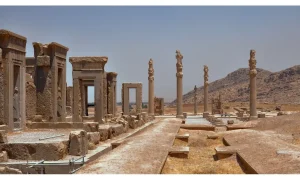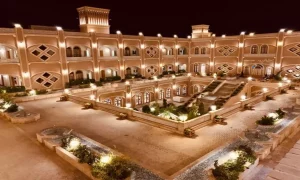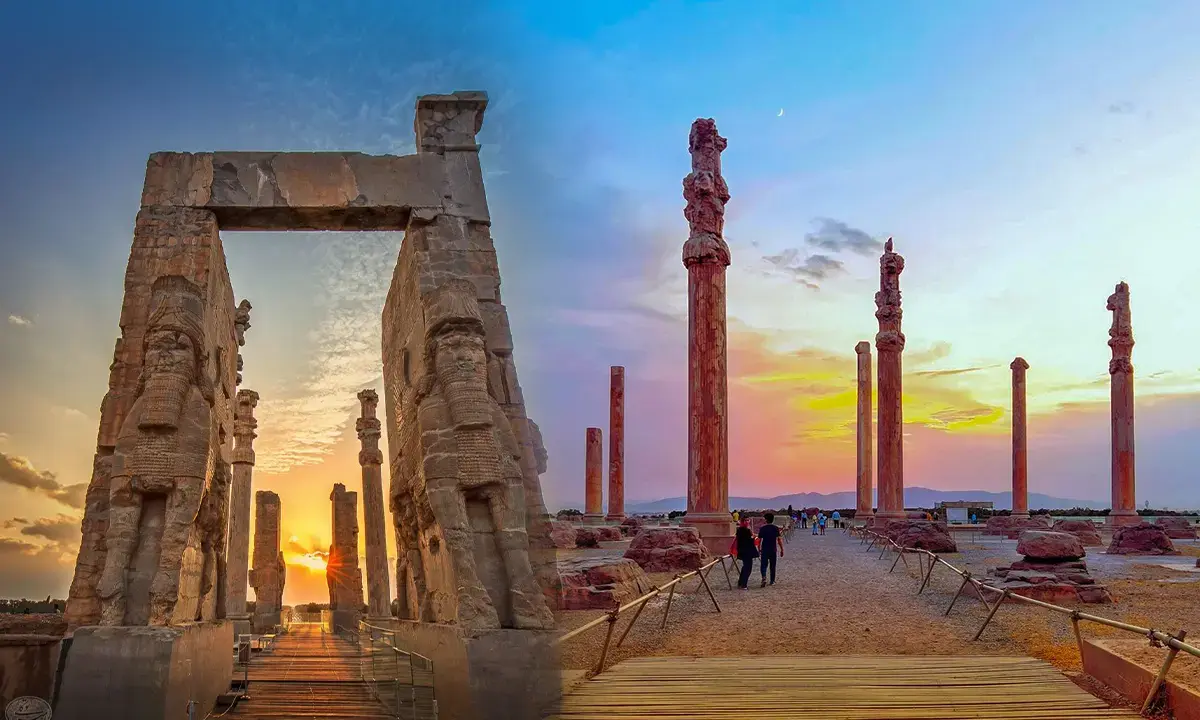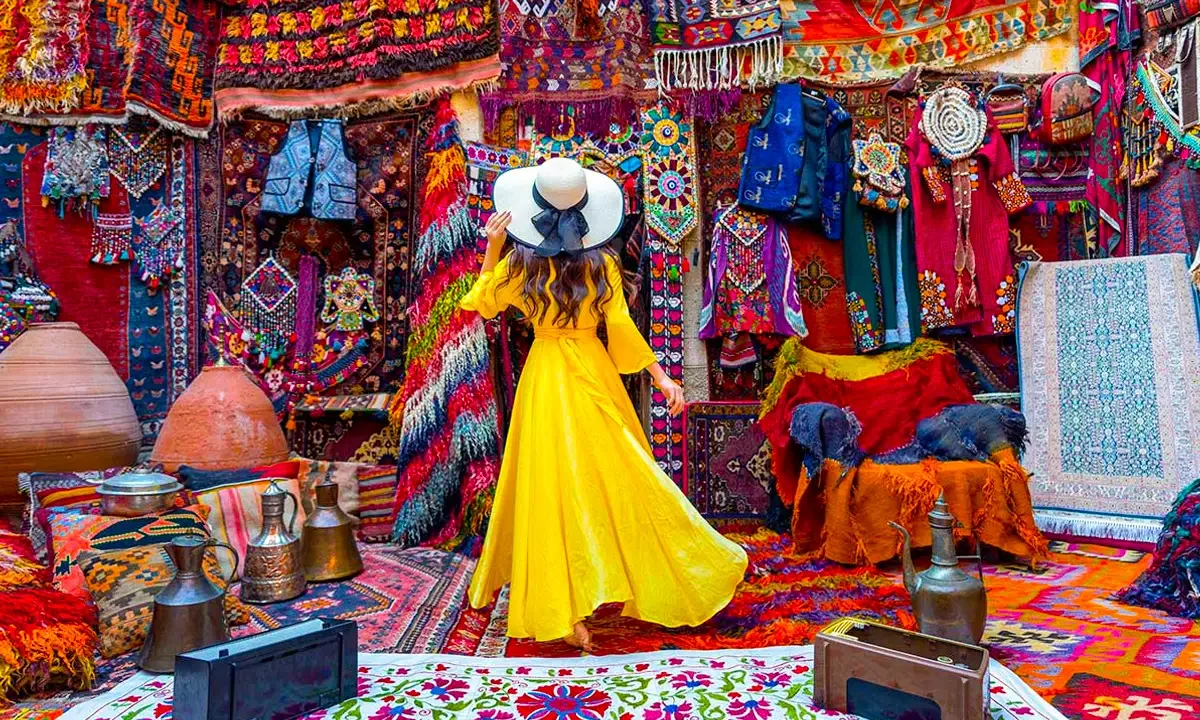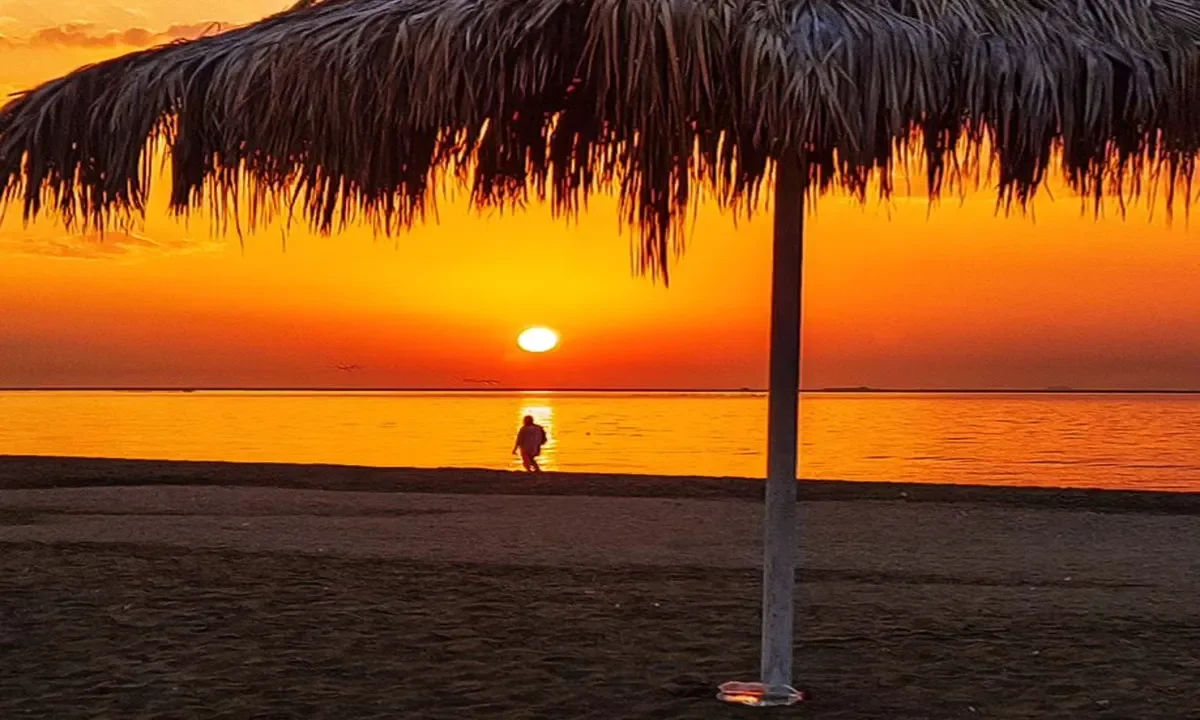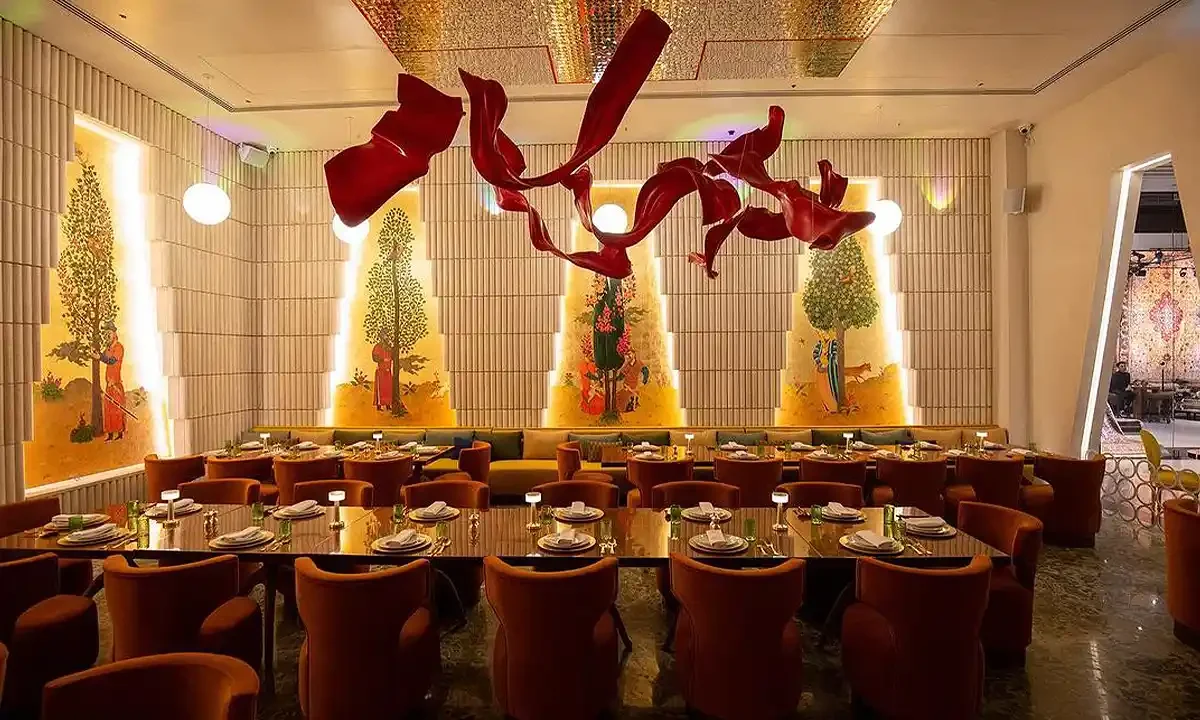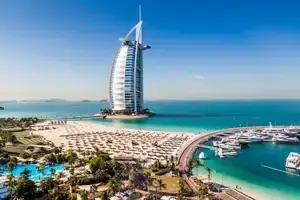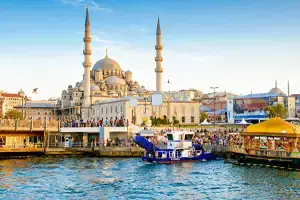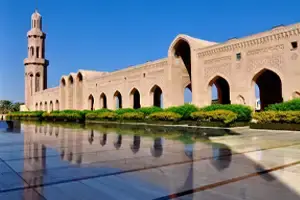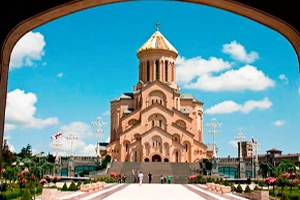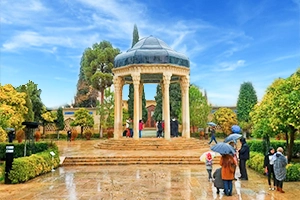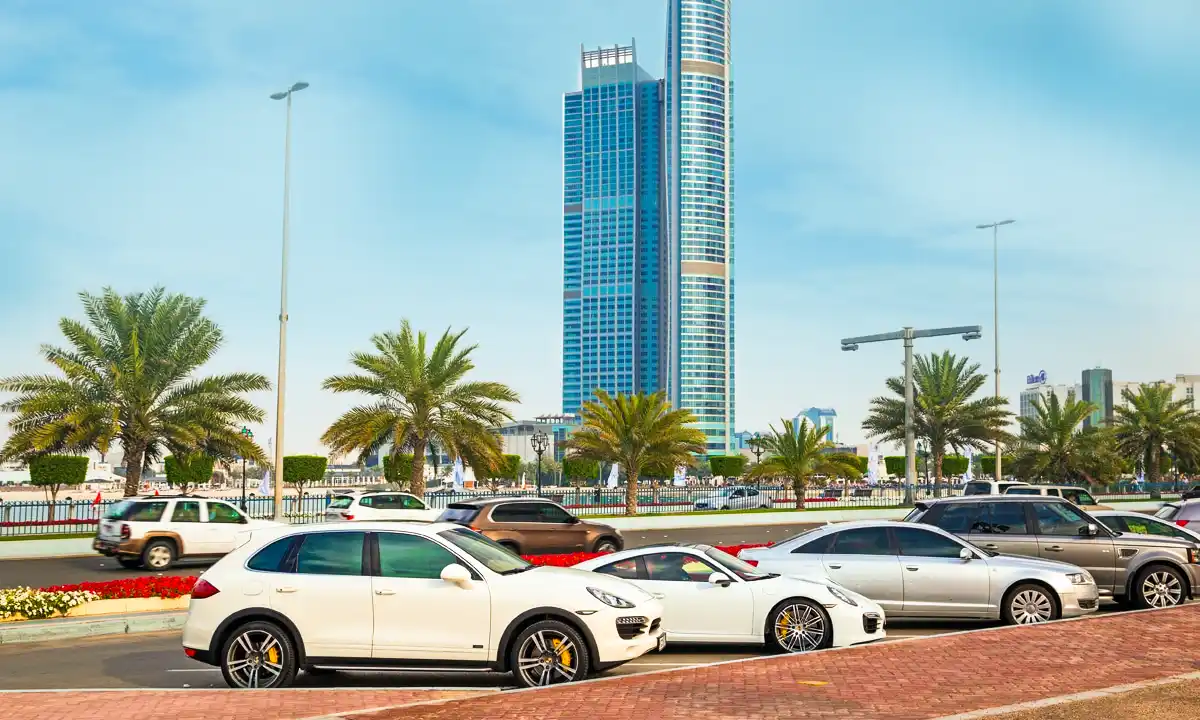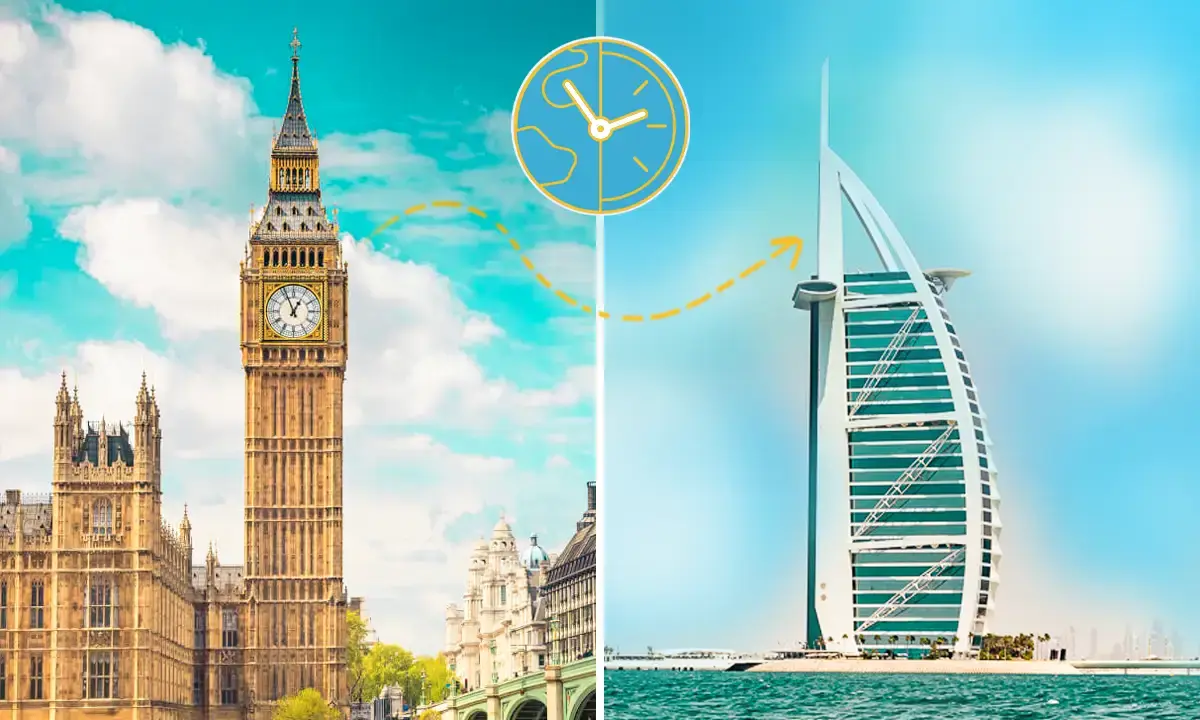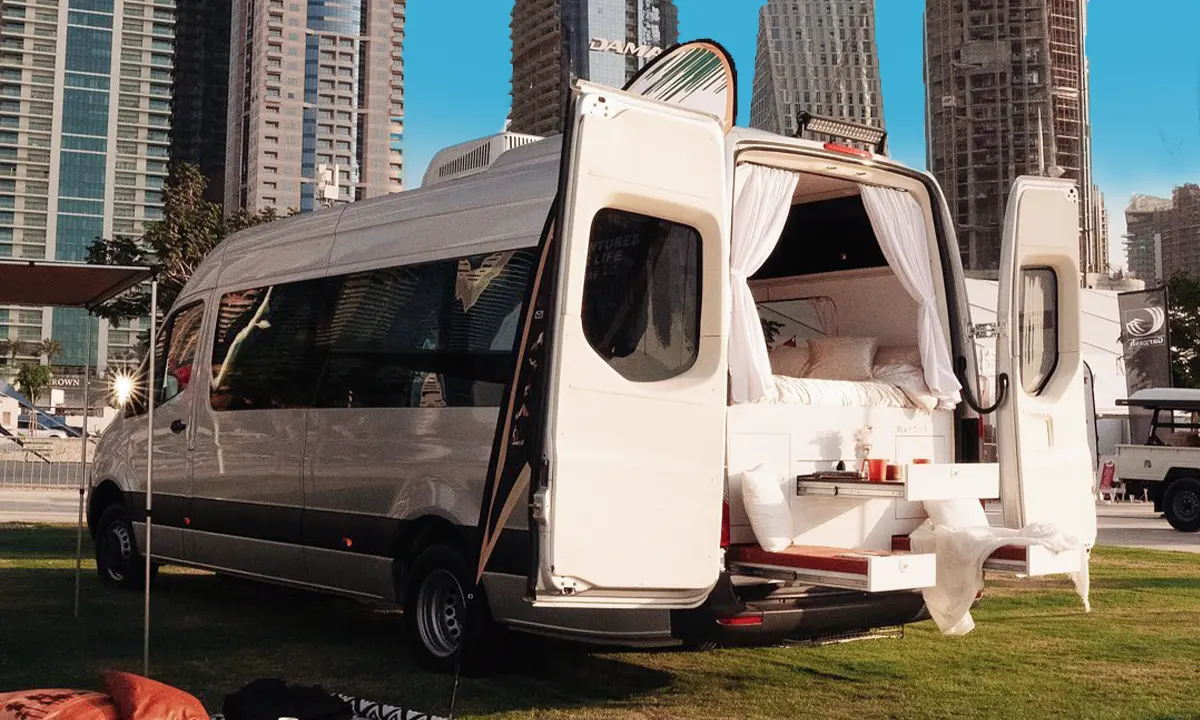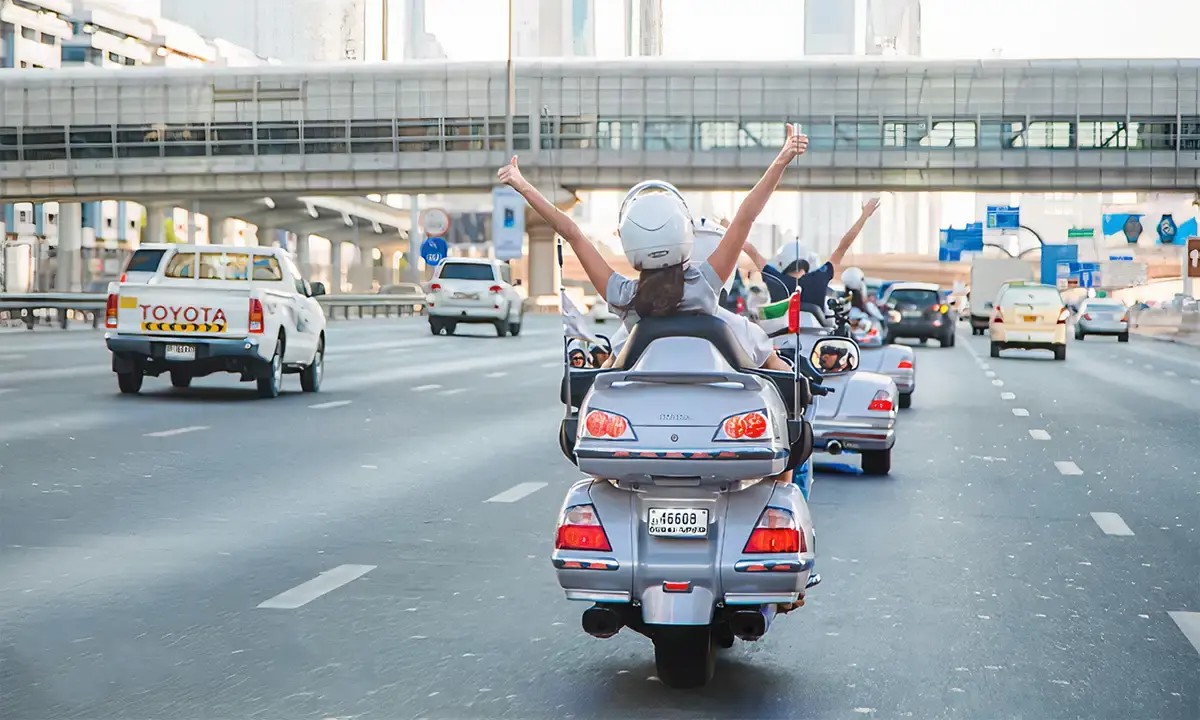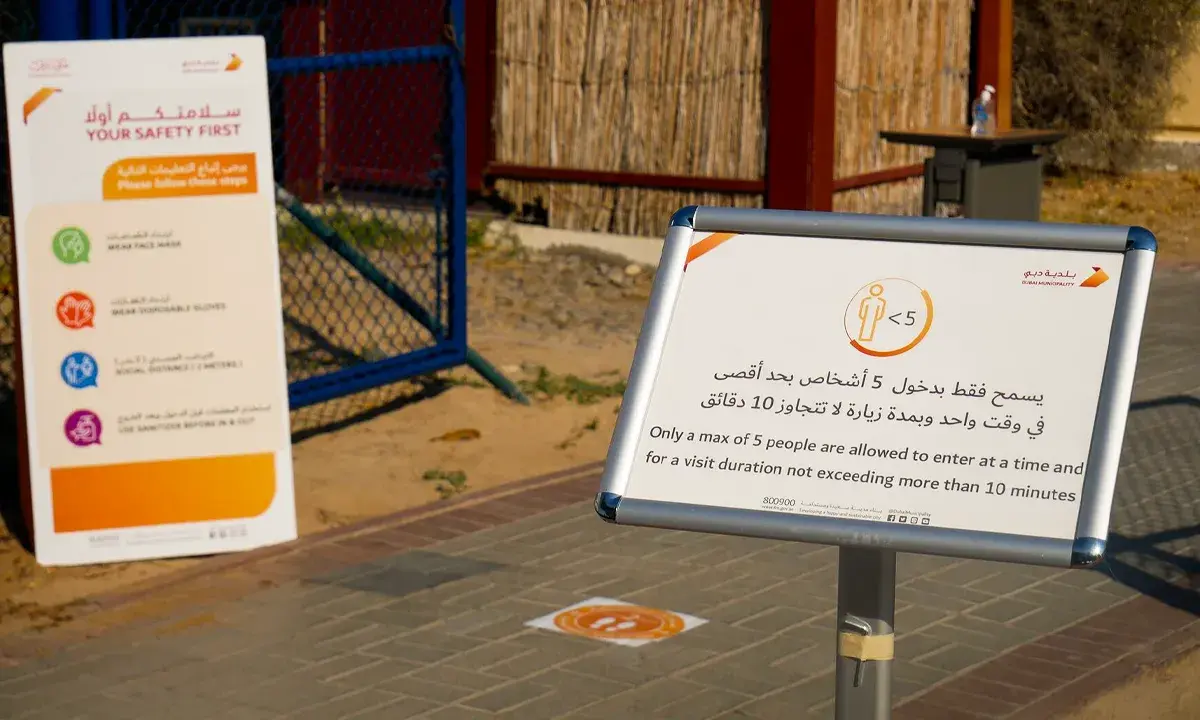Imagine a city where every corner tells a story of ancient civilizations, where art and architecture transport you to a bygone era. This is Isfahan, the cultural jewel of Iran. Despite its rich history, many travelers overlook Isfahan for more well-known destinations. Yet, those who venture here are rewarded with an unforgettable experience of Iran’s cultural and architectural heritage. With 2024 promising new attractions and enhanced visitor experiences, Isfahan’s allure has never been greater.
This guide by Alirezaa Karimian, a resident of Isfahan for over 20 years, will take you through its must-see attractions, hidden gems, accommodation and dining recommendations, and practical travel advice. From the majestic Naqsh-e Jahan Square to the intricate Sheikh Lotfollah Mosque, discover everything you need to make your 2024 visit to Isfahan remarkable.
Why Visit Isfahan in 2024?
Isfahan, often referred to as “Nesf-e Jahan” (Half the World), holds a pivotal place in Iranian history and culture, showcasing the country’s architectural innovation and artistic excellence. As the capital of the Safavid Empire in the 16th and 17th centuries, Isfahan blossomed into a center of Persian culture and politics, drawing intellectuals, artists, and religious scholars from across the globe. Its grand boulevards, covered bridges, palaces, mosques, and minarets are more than just tourist attractions; they are testaments to the city’s historical importance and enduring legacy. The city’s architecture, with its intricate Islamic tilework, sprawling public squares, and lush gardens, reflects the zenith of Persian art and craftsmanship, making Isfahan a crucial chapter in the narrative of Persian civilization.
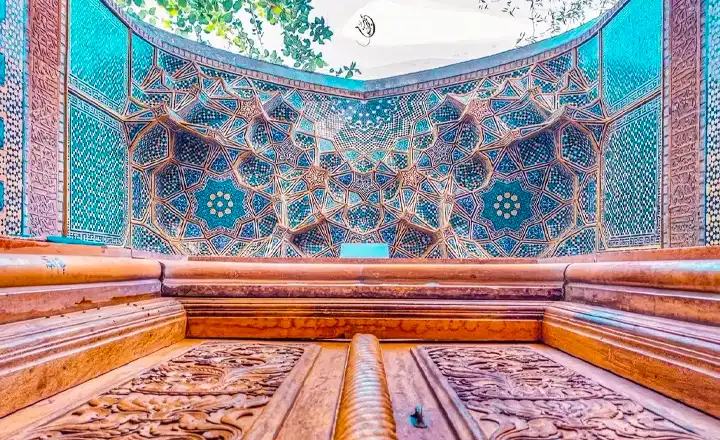
New update of Isfahan Tourist Attractions, 2024
In 2024, Isfahan is set to enhance its appeal as a premier travel destination with several updates and additions to its already impressive array of attractions. Anticipated developments include:
- Revitalization Projects: Key historical sites such as the Ali Qapu Palace and several traditional bridges are undergoing restoration to preserve their architectural integrity and aesthetic appeal, ensuring that visitors experience these landmarks in their full glory.
- Cultural Festivals: A lineup of cultural festivals is scheduled to take place in 2024, showcasing traditional Persian music, crafts, and culinary arts. These events offer visitors a unique opportunity to immerse themselves in the rich cultural tapestry of Isfahan.
- Improved Visitor Facilities: To accommodate the growing number of tourists, Isfahan is improving its visitor facilities, including enhanced informational services, upgraded accommodation options, and better transportation links within the city. This includes the expansion of pedestrian zones in the city center, making it easier and more enjoyable for tourists to explore the city’s historic sites.
- New Attractions: The opening of new museums and galleries will provide deeper insights into Isfahan’s cultural heritage, including exhibitions dedicated to Persian calligraphy, miniatures, and modern art inspired by traditional themes.
These updates, coupled with Isfahan’s enduring cultural significance, make 2024 an ideal time to visit. Whether you’re a history buff, an art enthusiast, or simply in search of a travel experience filled with beauty and inspiration, Isfahan promises a journey through the very heart of Persian culture and heritage.
Iconic Attractions in Isfahan
Each site tells a story of artistic brilliance and historical significance, inviting visitors to step back in time and explore the rich heritage of this ancient city.
Naqsh-e Jahan Square
Description: Naqsh-e Jahan Square, also known as Imam Square, is one of the largest city squares in the world and a stunning example of Islamic architecture. Surrounded by monumental buildings linked by a series of two-storied arcades, it is a vibrant hub of social and economic life in Isfahan.
Historical Significance: Built in the early 17th century under Shah Abbas I, the square was designed to showcase the wealth and power of the Safavid Empire. It served as a place for royal ceremonies, polo games, and public gatherings, symbolizing the center of Persian culture and politics.
What to Expect: Visitors can expect to be awed by the square’s grandeur and the exquisite architecture of the surrounding buildings, including the Imam Mosque, Sheikh Lotfollah Mosque, and Ali Qapu Palace. The square is also home to the Isfahan Grand Bazaar, offering a plethora of traditional Iranian crafts.
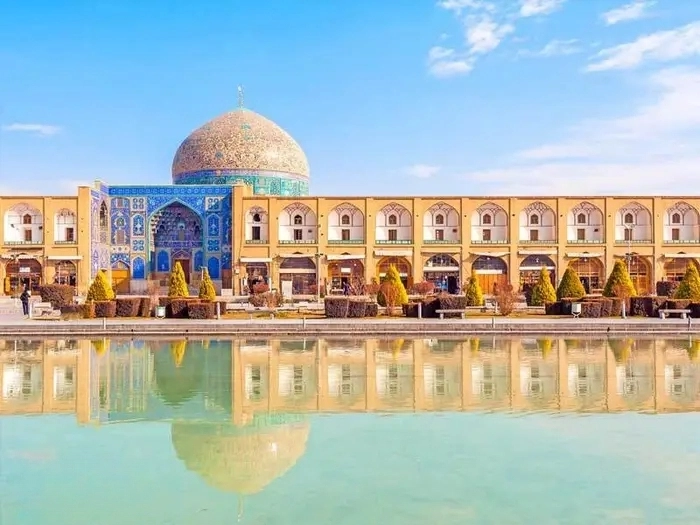
Imam Mosque
- Architectural Features: The Imam Mosque is an exemplary piece of Persian Islamic architecture known for its stunning blue-tiled mosaics and magnificent portal entrance. Its dome is one of the city’s landmarks, notable for its acoustics and intricate geometric designs.
- Visitor Tips: Best visited in the morning or late afternoon for the best light for photographs. Don’t miss the chance to experience the mosque’s central dome acoustic properties by standing directly under it.
- Place in Isfahan’s Religious History: The mosque, constructed during the Safavid period, is a symbol of Islamic devotion and Persian architectural achievement. It has played a central role in the religious life of Isfahan for centuries, serving as a place of worship and a community center.
Sheikh Lotfollah Mosque
- Unveiling its Unique Beauty: Unlike the Imam Mosque, Sheikh Lotfollah Mosque lacks minarets and a courtyard, designed instead as a private mosque for the royal family. Its dome changes color from dawn to dusk, reflecting the light in varying shades of cream to pink.
- Lesser-known Facts: The mosque was named after Sheikh Lotfollah, a prominent Lebanese scholar of the Safavid era. It is renowned for the peacock at the center of its dome, visible when the sunlight hits the tiles at a certain angle.
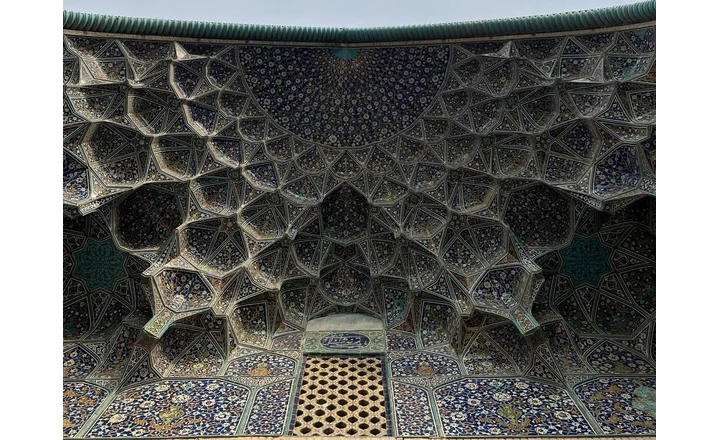
Ali Qapu Palace
- Role in Safavid Dynastic Politics: Ali Qapu was the royal palace of Shah Abbas I, serving as a majestic gateway to the royal palaces that lay in the parklands beyond Naqsh-e Jahan Square. It played a crucial role in the administration of the empire and in hosting foreign dignitaries.
- Architectural Marvels: The palace is famous for its elevated terrace that offers stunning views of the square, its music hall with intricate acoustic designs, and the richly decorated rooms that showcase the lavish lifestyle of the Safavid monarchs.
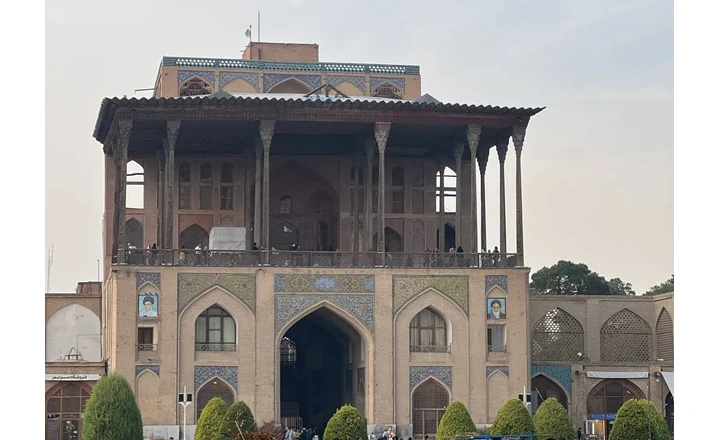
Si-o-Se Pol and Khaju Bridge
- Engineering Genius: Si-o-Se Pol (Bridge of 33 Arches) and Khaju Bridge are two of the eleven bridges in Isfahan, celebrated for their architectural and engineering excellence. Built-in the 17th century, these bridges serve both as vital crossings of the Zayanderud River and as public meeting spaces.
- Role in Isfahan’s Social Life: Beyond their functional role, these bridges have historically been places of leisure and social gatherings for the people of Isfahan. The platforms and alcoves built into the bridges were designed for tea drinking, chatting, and enjoying the cool air in the evening, continuing to be a central part of social life in the city.
These iconic attractions not only highlight the architectural and cultural achievements of Isfahan but also offer visitors a window into the city’s rich historical tapestry and vibrant social life.
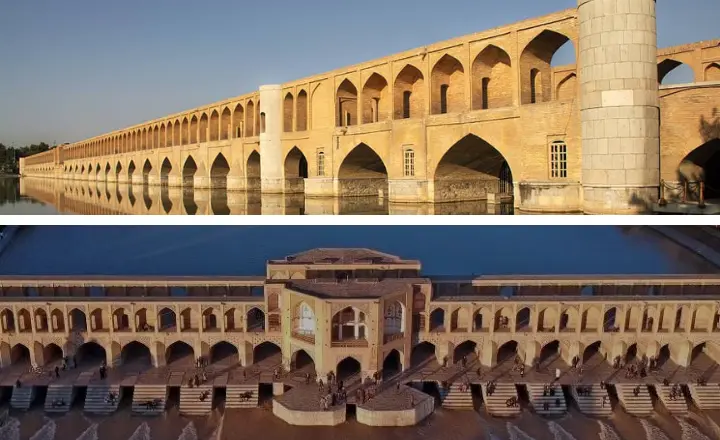
Other Notable Attractions in Isfahan
- Vank Cathedral: Located in the Armenian Quarter of Jolfa, Vank Cathedral showcases a stunning mix of Islamic and Christian architecture. Its interior is adorned with elaborate frescoes depicting biblical scenes, making it a unique cultural and religious site.
- Chehel Sotoun Palace: Known as the Palace of Forty Columns, this 17th-century pavilion is set in the middle of a picturesque garden. The name reflects the reflection of the twenty slender wooden columns supporting the entrance pavilion in the waters of the front pool, giving the appearance of forty columns. It’s famous for its magnificent hall of mirrors and historical frescoes.
- Jameh Mosque of Isfahan: One of the oldest mosques in Iran, the Jameh Mosque is a stunning example of Islamic architecture over the centuries. It features a vast complex with several beautiful courtyards, domes, and prayer halls adorned with intricate tilework.
- Hasht Behesht Palace: Dating back to the Safavid era, Hasht Behesht translates to “Eight Paradises” and is known for its octagonal shape. This small but exquisite palace is surrounded by a lush garden and features stunning murals, marble fountains, and a beautifully decorated ceiling.
- Zayanderud River: The lifeblood of Isfahan, this river is flanked by parks and walking paths, making it a popular gathering spot for locals and tourists alike. The historic bridges over the river, such as Si-o-Se Pol and Khaju Bridge, become lively places of social interaction in the evenings.
- Qeysarie Gate: The entrance to the Grand Bazaar of Isfahan, located at one end of Naqsh-e Jahan Square. The gate is notable for its stunning mosaic tilework and calligraphy, leading to a labyrinth of alleys filled with shops selling Persian rugs, silverware, and traditional handicrafts.
- Menar Jonban (Shaking Minarets): A fascinating architectural wonder, the Menar Jonban is famous for its minarets that can be made to sway gently by applying force at the top. This phenomenon attracts visitors curious about its unique construction.
- Bird Garden: Home to a wide variety of bird species, the Bird Garden of Isfahan is an enjoyable attraction for families and nature lovers. It provides an opportunity to see exotic birds up close in a well-maintained environment.
- Music Museum: This museum offers insights into Iran’s rich musical heritage, displaying a vast collection of traditional Persian musical instruments. Visitors can also enjoy live performances and learn about the history of music in Iran.
- Flower Garden: Spanning over an area of 5 hectares, the Flower Garden of Isfahan is a beautiful and serene place to enjoy a wide range of flowers and plants. It’s a perfect spot for relaxation and photography, especially during the spring and summer months.
Cultural Experiences
- Bazaar of Isfahan
The Bazaar of Isfahan, stretching from Naqsh-e Jahan Square towards the Jameh Mosque, is not just a market but a historical corridor where the pulse of Isfahan’s rich culture beats. This sprawling bazaar is a labyrinth of alleyways, caravanserais, and shops that seem frozen in time. Visitors can explore an array of traditional crafts, from intricately woven Persian rugs and handmade copperware to miniatures and marquetry. The scent of spices and the sound of hammering copper blend with the call to prayer, creating a vibrant atmosphere that transports you to the heart of Persian commerce and craftsmanship. Engaging with local artisans provides insight into the traditions and skills passed down through generations, making it a deeply enriching cultural experience.
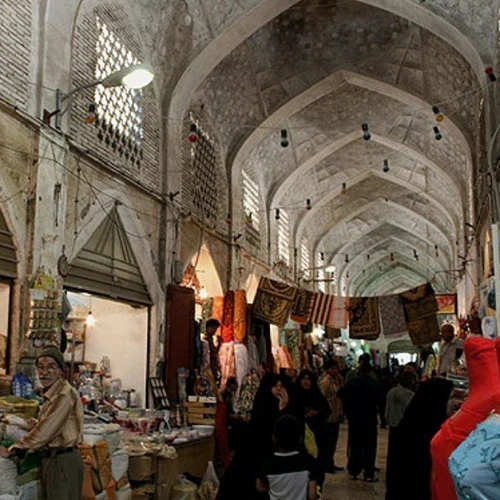
- Armenian Quarter (Jolfa District)
The Jolfa District, Isfahan’s Armenian Quarter, is a testament to the city’s multicultural heritage. At its heart is the Vank Cathedral, a stunning 17th-century Armenian church with an ornate interior combining Islamic and Christian architectural elements. The cathedral’s museum offers valuable insights into the history of the Armenian community in Isfahan, showcasing manuscripts, religious artifacts, and a detailed account of their migration to the city. Exploring Jolfa provides a unique perspective on the cultural diversity that defines Isfahan, with its cozy cafés, art galleries, and the serene ambiance of its streets, further highlighting the Armenian contribution to the city’s cultural fabric.
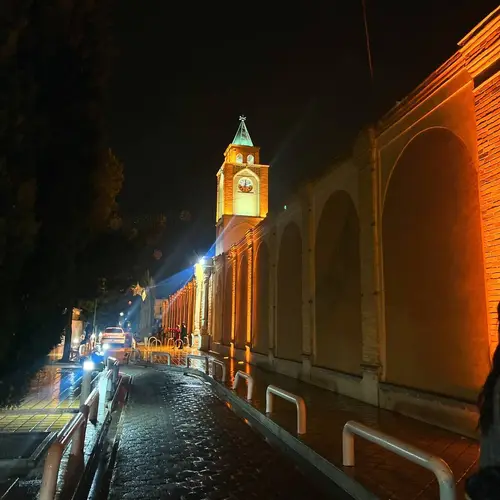
- Traditional Persian Gardens
Persian gardens, such as Chehel Sotoun, embody the essence of paradise on earth, a concept deeply rooted in Persian culture and aesthetics. These gardens are designed according to strict geometrical principles, representing the four Zoroastrian elements of sky, earth, water, and plants. Chehel Sotoun, with its iconic pavilion set against the backdrop of a reflecting pool and surrounded by meticulously landscaped gardens, offers a tranquil retreat from the city’s hustle and bustle. The integration of indoor and outdoor spaces, water channels, and the use of shade and vegetation for cooling, not only showcases the ingenuity of Persian garden design but also offers a serene space for contemplation and enjoyment of nature. Visiting these gardens is a cultural experience that reveals the philosophical and artistic depth of Persian civilization, emphasizing harmony with nature and the pursuit of beauty.
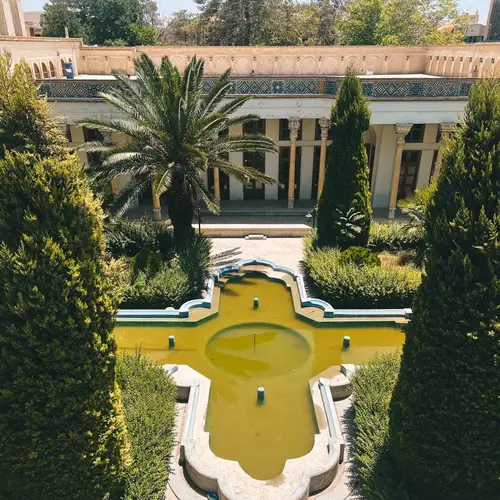
Hidden Gems of Isfahan
Isfahan, a city rich in history and culture, holds numerous secrets in its ancient streets and alleys. Beyond the well-trodden paths lie hidden gems that offer a deeper understanding of the city’s heritage and provide unique experiences for those willing to explore. Here’s a look at some of Isfahan’s lesser-known attractions and tips for discovering the city’s off-the-beaten-path treasures.

Lesser-known Attractions
- Atashgah – The Zoroastrian Fire Temple: Perched on a hill just outside of Isfahan, Atashgah is a testament to the city’s pre-Islamic history. This ancient Zoroastrian fire temple offers not only a glimpse into the religious practices of the past but also panoramic views of Isfahan.
- Menar Jonban – The Shaking Minarets: Although mentioned briefly, the phenomenon of the shaking minarets deserves deeper exploration. Visitors can witness this architectural marvel firsthand, where a gentle sway in one minaret results in the synchronous movement of the other, showcasing the ingenuity of medieval Persian architecture.
- Jameh Mosque’s Lesser-Known Iwans and Prayer Halls: While the Jameh Mosque is a popular attraction, many of its intricacies are often overlooked. Venture beyond the main courtyard to discover quiet prayer halls and iwans that are adorned with exquisite tilework, offering a peaceful respite from the more crowded areas.
- The Pigeon Towers of Isfahan: These unique structures dotted around the outskirts of the city were once used for collecting pigeon droppings as fertilizer. The towers, with their intricate designs to house thousands of pigeons, are a fascinating example of sustainable agricultural practices in historical Persia.
- Isfahan’s Historical Houses: Explore the opulent historical houses of Isfahan, such as the Chehel Sotoun Palace and others, which offer a glimpse into the lifestyle of the Persian elite. These beautifully preserved homes feature stunning frescoes, elaborate stucco work, and traditional Persian gardens.
Tips for Exploring Off-the-Beaten-Path Sites
- Hire a Local Guide: A knowledgeable local guide can provide insights into the history and significance of lesser-known sites that you might miss otherwise.
- Plan Your Visit During Off-Peak Hours: Visiting early in the morning or late in the afternoon can help avoid crowds and allow for a more personal experience with the attractions.
- Engage with Locals: Interaction with residents can lead to recommendations for hidden gems not listed in guidebooks. Isfahani people are known for their hospitality and may even invite you into their homes or private spaces that are off-limits to the general tourist population.
- Explore on Foot or Bicycle: Many of Isfahan’s hidden treasures are located in narrow alleys or areas not accessible by car. Walking or cycling can provide a more intimate look at the city’s lesser-known facets.
- Read Up on Isfahan’s History Before Visiting: Having background knowledge about the city’s rich history will make the discovery of its hidden gems more meaningful and rewarding.
By venturing beyond the main tourist attractions, visitors to Isfahan can uncover the city’s hidden history, architectural marvels, and cultural depth, offering a truly unique and enriching travel experience.
Planning Your Visit
A well-planned visit to Isfahan not only ensures a memorable experience but also allows for a deeper appreciation of the city’s rich cultural tapestry. Here are some tips on the best time to visit, getting around, and adhering to local customs and traditions.
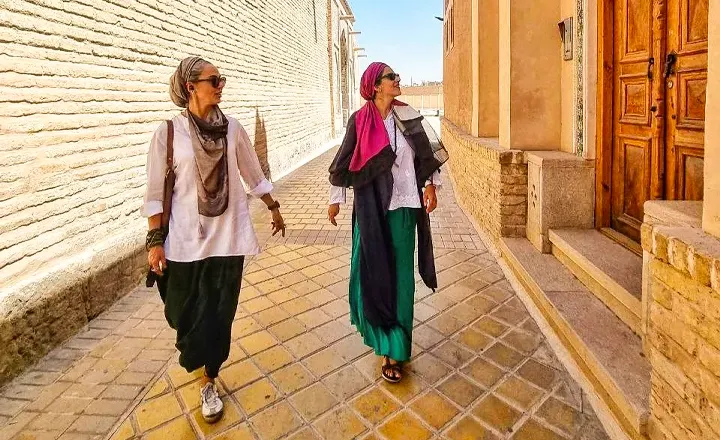
Best Time to Visit
- Seasonal Considerations: The ideal time to visit Isfahan is during the spring (March to May) and autumn (September to November) months. During these periods, the weather is pleasant, with mild temperatures perfect for exploring the city’s outdoor attractions. The gardens are in full bloom in spring, while autumn brings a cool, comfortable climate.
- Annual Cultural Events: Time your visit to coincide with cultural festivals to experience Isfahan at its most vibrant. The Nowruz (Persian New Year) celebrations in March offer a fascinating insight into Iranian traditions. Another event not to be missed is the Isfahan Film Festival, held annually, which attracts filmmakers and enthusiasts from around the world.
Getting Around Isfahan
- Public Transport: Isfahan’s public transport system includes buses and a limited metro line. While these can be efficient for reaching distant attractions, services might be confusing for first-time visitors due to limited English signage.
- Taxis and Ride-hailing Apps: Taxis are readily available and reasonably priced. For greater convenience, consider using local ride-hailing apps, which offer the advantage of set fares and the ability to request a ride without a language barrier.
- Bicycles and Walking: Isfahan is relatively flat, making it ideal for exploring by bicycle or on foot, especially within the city center. Many of the city’s major attractions are located close to each other, making walking a pleasant and practical option.
- Car Rental: Car rental in Isfahan provides a flexible way to explore the city and its surroundings. Available at the airport and citywide, it’s suited for those with a valid license and IDP, offering convenience despite local traffic and parking considerations.
Isfahan Tourist Map
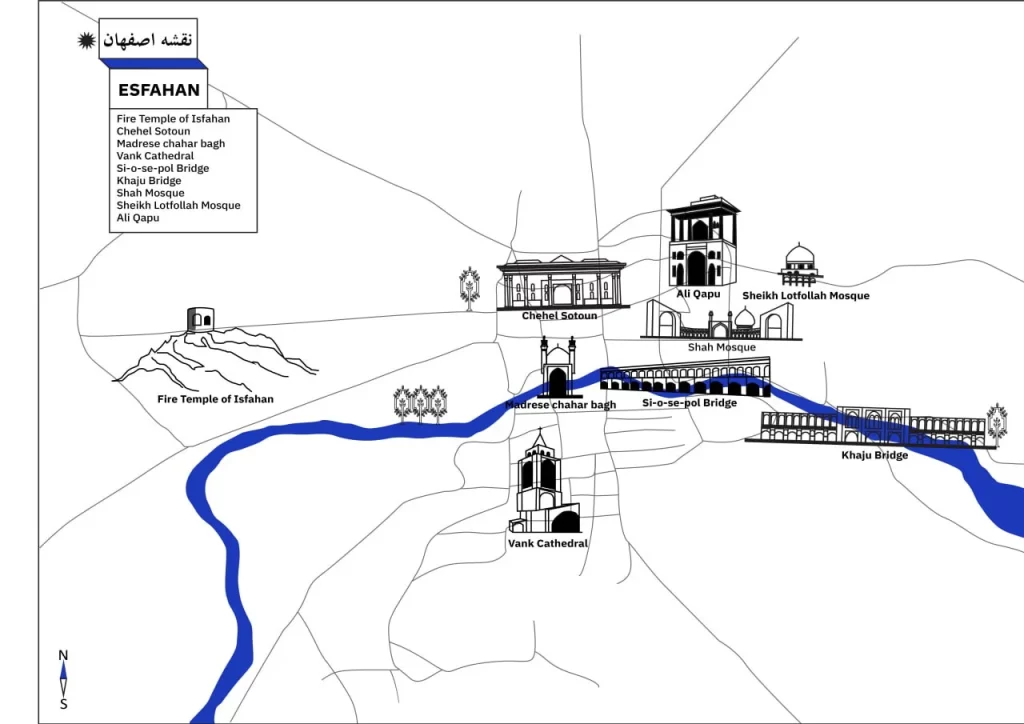
Cultural Etiquette
- Dress Code: Respect the local dress code. Men and women are expected to dress modestly in public places. Women should wear a headscarf and avoid tight-fitting clothes, while men should wear long pants.
- Social Interactions: When interacting with locals, be mindful of Islamic customs. Avoid physical contact with the opposite sex unless initiated by them. Always greet people with a polite “Salam” (Hello).
- Visiting Religious Sites: When entering mosques and religious sites, remove your shoes and ensure you’re appropriately dressed. Women may be required to wear a chador (a full-body cloak) provided at the entrance of some mosques.
- Photography: Always ask for permission before taking photos of people, especially women. Be cautious when photographing government buildings or military personnel, as this can be sensitive.
By considering these factors when planning your visit, you can ensure a smooth and respectful journey through Isfahan, allowing you to fully immerse yourself in the wonders of this ancient city.
Accommodation and Dining
Isfahan offers a range of accommodation options to suit all preferences and budgets, from traditional guesthouses brimming with Persian character to modern luxury hotels offering all the comforts of home. Dining in Isfahan is an experience in itself, with a variety of traditional dishes that reflect the city’s rich culinary heritage.
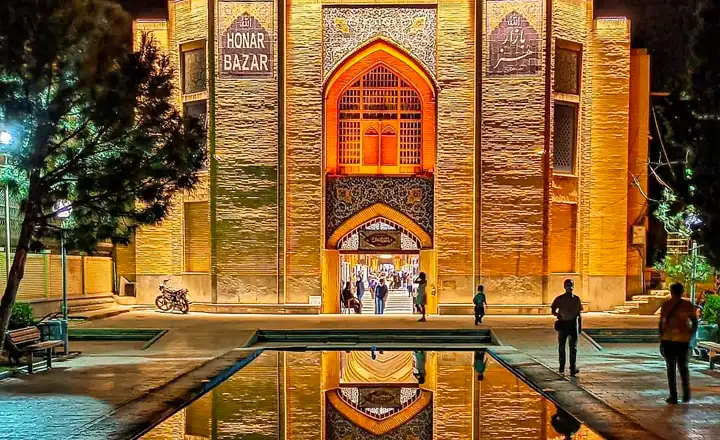
Accommodation
- Traditional Guesthouses: For a truly authentic Isfahani experience, consider staying in one of the city’s traditional guesthouses. Often located in historic buildings, these guesthouses offer a glimpse into the architectural elegance of Persian residential design, featuring beautiful courtyards, intricate tilework, and classic Persian hospitality. Examples include the Abbasi Hotel, which is known for its stunning Safavid-era architecture.
- Luxury Hotels: Those looking for more modern amenities without sacrificing the charm and beauty of Isfahan can opt for luxury hotels such as the Hotel Kowsar or the Isfahan International Hotel. These hotels offer spacious rooms, fine dining restaurants, and, in some cases, breathtaking views of the city’s landmarks.
- Budget Options: Budget travelers have plenty of options as well, from economical hotels to backpacker hostels. These accommodations provide basic amenities and a comfortable place to rest after a day of exploring the city.
Dining
Isfahani cuisine is a delightful exploration of flavors and traditions. The city’s culinary scene ranges from traditional teahouses and street food stalls to upscale restaurants serving classic Persian dishes.
- Traditional Isfahani Cuisine: Must-try local dishes include Beryani (Beryoon), a minced lamb dish flavored with saffron and cinnamon, and Khoresht-e mast, a unique yogurt stew sweetened with saffron and orange peel. For dessert, Gaz, Isfahan’s famous nougat, and Fereni, a rosewater and rice flour pudding, are not to be missed.
Best Places to Experience Local Dishes:
- Azadegan Teahouse (Chah Haj Mirza): Known for its cozy atmosphere and decor, it’s an ideal spot to try traditional Persian tea and desserts.
- Shahrzad Restaurant: Offers a classic dining experience with a menu featuring a wide range of Persian specialties, including local favorites.
- Naqsh-e Jahan Square Street Vendors: For those looking to sample local snacks and sweets while exploring the city, the street vendors around Naqsh-e Jahan Square offer a variety of traditional treats.
Modern and International Cuisine:
In addition to traditional fare, Isfahan boasts several restaurants and cafes serving modern Persian and international cuisine, catering to all tastes and dietary preferences.
By choosing accommodations that reflect your style and diving into the rich culinary landscape of Isfahan, visitors can enhance their travel experience, making it as comfortable and rewarding as it is memorable.
Practical Tips for Travelers
Traveling to Isfahan, like any international destination, requires some preparation to ensure a smooth and enjoyable experience. Here are some practical tips covering visa requirements, currency, language basics, and safety for travelers planning a visit to this historic city.
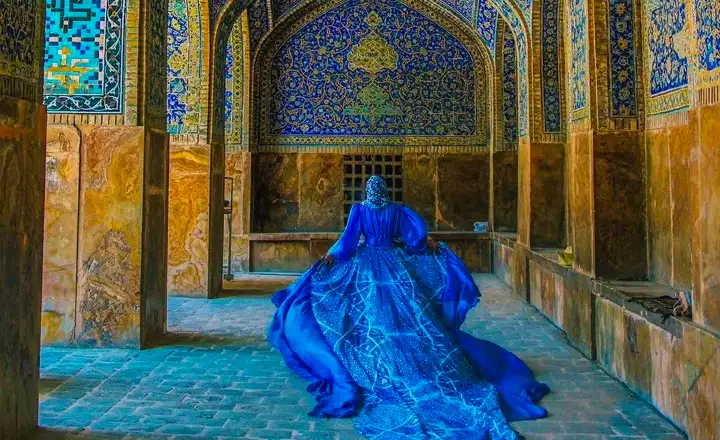
Visa Requirements
General Requirements: Most foreign nationals require a visa to enter Iran. Visa-on-arrival (VOA) is available for tourists from many countries at several major airports, including Isfahan International Airport, but it’s recommended to apply for a visa in advance through an Iranian embassy or consulate to avoid any potential issues upon arrival.
E-Visa Application: Iran’s e-visa system allows applicants to submit their visa applications online before their trip. Check the official e-visa website for the latest information on the application process and required documents.
Currency Tips
- Local Currency: The official currency of Iran is the Iranian Rial (IRR), but prices are often quoted in Toman (1 Toman = 10 Rials). It’s essential to clarify which unit is being used to avoid confusion.
- Cash is King: Due to international sanctions, international credit cards (Visa, MasterCard) do not work in Iran. Bring sufficient cash for the duration of your stay and exchange it to Rials at authorized currency exchange offices, banks, or your hotel.
- Exchange Rate: Be mindful of the exchange rate and know that it can fluctuate. Use reputable exchange services and always count your money carefully after each transaction.
Language Basics
Official Language: Persian (Farsi) is the official language. Learning a few basic phrases can enhance your travel experience and help you connect with locals. For example:
- Hello: Salam
- Thank You: Merci (borrowed from French but widely used) or Mamnoon
- Yes: Baleh
- No: Na
English Proficiency: In tourist areas and among younger Iranians, you’ll find a reasonable level of English proficiency, making it easier to communicate basic needs and directions.
Safety Advice
- General Safety: Iran is generally safe for travelers, including solo female travelers, with low rates of violent crime. Exercise common sense and be aware of your surroundings, especially in crowded places.
- Cultural Sensitivity: Respect local laws and Islamic customs. Dress modestly, avoid public displays of affection, and always ask permission before taking photos of people.
- Travel Insurance: Ensure that your travel insurance covers your trip to Iran, as some policies may have exclusions. Verify that it includes medical coverage.
- Stay Informed: Keep abreast of local news and any travel advisories from your country’s foreign affairs department or embassy in Iran. Be aware of regional holidays and significant political anniversaries, as these can affect the opening hours of sights and public transport.
By adhering to these practical tips, travelers can navigate the cultural, linguistic, and logistical aspects of visiting Isfahan, ensuring a rewarding and hassle-free experience in one of Iran’s most enchanting cities.
Last Word
Isfahan, with its rich cultural heritage and stunning architecture, is a must-visit destination in 2024. From the grandeur of Naqsh-e Jahan Square to the intricate details of its mosques and palaces, the city offers a blend of history and vibrant traditions. Revitalized historical sites and cultural festivals enhance the immersive experience. Discover Isfahan’s well-known landmarks and hidden gems, and witness the enduring spirit of its people. Let 2024 be the year you explore Isfahan, where every corner tells a story and every moment connects to the past.
FAQ
Do I need a visa to visit Isfahan, Iran?
Yes, most foreign nationals require a visa to enter Iran. You can apply for a visa in advance through an Iranian embassy or consulate in your country or use the e-visa application system. Tourists from certain countries can obtain a Visa on Arrival (VOA) at major airports, but it’s advisable to arrange your visa before your trip for peace of mind.
What is the best time of year to visit Isfahan?
The best time to visit Isfahan is during the spring (March to May) and autumn (September to November) months. These seasons offer mild weather, making it comfortable to explore the city’s outdoor attractions.
Is it safe to travel to Isfahan?
Isfahan is generally considered safe for tourists, including solo travelers and women. However, as with any travel destination, it’s important to stay aware of your surroundings, especially in crowded places, and respect local customs and laws.

